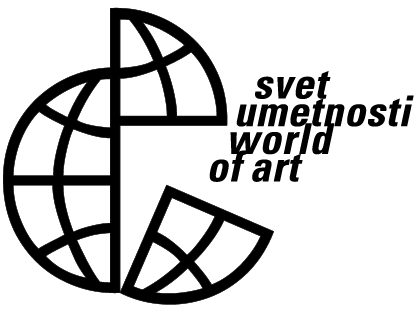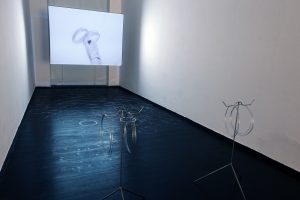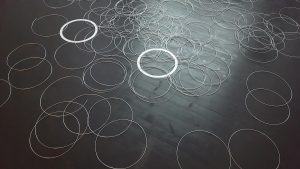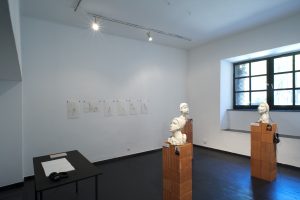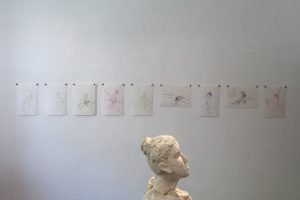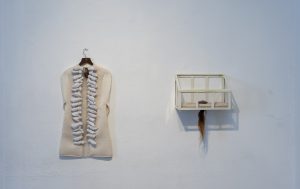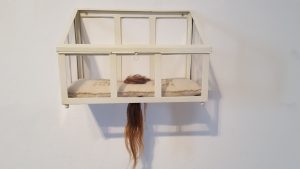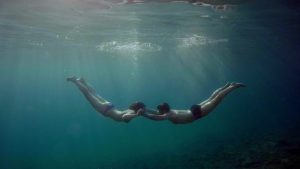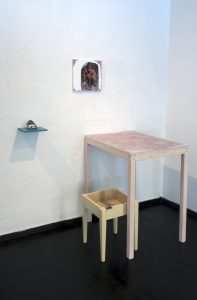Personal
Final exhibition of 15th generation of the World of Art, School for Curators and Critics of Contemporary Art
26 May–15 July 2016
Škuc Gallery, Stari trg 21, Ljubljana
Exhibited works
Boris Beja, Du bist, series of photographs, 2015
Some of the photographs from the Du bist series were taken at an international airport, a space of transition, where the waiting area was transformed into a ritual space in half an hour. Beja documents the religious ritual of Orthodox Jews. No one’s home changes into a social place only when we belong to different groups or adopt roles governed by social norms and rules of behaviour. The ritual pattern is complemented by the formal pattern of the Trinomino board game played by the artist at his table at home: like every ritual, the game has predefined rules, which have to be followed in order to win. The method of playing the board game led to the title of the project: the simple expression “du bist”, signifying “it is your turn” was used by both players to create new and different with triangular dominoes.
In both cases, the artist is an observer who uses photographs to examine the sense of belonging, rituals and contract between order and chaos by recording and categorising details from his everyday life. Cultural patterns, habits, (dis)regard for rules and agreements and gestures help us build patterns and relationships. “All of us, who participate in a society, are part of du bist,” Beja says.
Živa Božičnik Rebec, “This is my space and this is your space, ok!?!”, interactive installation, 2012
The title of the work by Živa Božičnik Rebec refers to the response of the person whose personal space has been violated. However, every individual has completely subjective notion of what personal space is. It can only be shared without any protest by detecting the individual’s position of power, which, however, constantly shifts with regard to different dynamics between people. A similar statement applies to groups, which we become part of more or less consciously. The position of thrown rings and the recording of drawing them metaphorically present the position of persons and methods of building social connections: we cross rings like we cross masses of people and find our personal space in them. By throwing a ring, the viewer can choose which ring or group they want to join. Throwing the ring requires the viewer to actively become close and also gives them the possibility to become more distant. In this respect, it is true that the goal of the ring can never be truly controlled, just like personal perceptions of our intimate or social space never really completely overlap.
Nina Čelhar, Diaries, a series of paintings (with sketchbooks), 2011
For Nina Čelhar, painting is something very personal. Painting is a necessity, the canvas is the artist’s “therapist”, and everyday company of the canvas is vital. Her first series of paintings, which is also her diploma work, is called Diaries. Despite having exhibited in several galleries in Slovenia and abroad, this is the first public presentation of the series.
The technique, which is mixed (tempera, gouache, charcoal, chalk, pastels, etc.) and the scattered, seemingly insignificant details, are the result of the artist’s current mood. Lively painting process establishes a rich collage of different content over the entire surface of the painting, which included different paper documents, sketches, wrappings and labels of different size. Most colours are lively and contrasting, primary colours in all their purity. The figure is simplified and contoured, sometimes without a face. Although, it is still there, it no longer has the role of the main mediator.
By painting on canvas and in sketchbooks, the artist records her everyday life and herself. She seeks to better define her everyday intimate problems and experience on canvas by finding logical supporting scenes, thereby connecting images, events and feeling that were not connected in real time and do not have the same significance, into a new whole.
Neža Knez, Other view, space installation with gypsum portraits, drawings, sound recording and diaries, 2015
The artwork is based on the artist’s transformative experience of temporarily taking her own sight, which enabled her to examine her worldview without one of the basic sensory stimuli. The artist followed a phenomenological concept: in a period of twenty-four days (seven days before, ten days during and seven days after the temporary blindness) she consciously monitored her experience and documented her perception of the world while being completely blindfolded. The artwork comprises several parts documenting the artist’s observation of herself, the world and herself in the world, while stressing the subjectivity of any perception of time and space.
Four sets of documentation of the artist’s temporary sightless life are on view. Gypsum busts examine the possibility of translating information in the movement of the arms. The first portrait was created on the basis of a verbal description of a person, the second by translating transpose the touch of the facial features into gypsum, while the third is a portrait of an acquaintance in line with artist’s personal memory. Studies of a nude, a required work at the Academy of Fine Arts and Design, which she made while blindfolded, show her interpretation of information acquired from her colleagues, whose eyes (view and perception) she ‘borrowed’ during her ten-day blindness. Book of sketches displays the artist’s notes and sketches during her blindness, while a small booklet and an audio document are a transcript and recording of experience-based research (descriptive sampling of experience) lasting for the whole duration of the twenty-four day project, which offers insight into her feelings before, during and after blindness.
Tejka Pezdirc, Body Trace: Bones of Her Back, She, space installation, 2014–2015
Feeling the present through testimonies of the past, and reviving and creating conceptual spaces of unrealised powers of women is represented by two pieces of sculpture under the joint title Body Trace. The installation by Tejka Pezdirc comprises sculptures entitled Bones of Her Back and She, which speak about bodies and fates of two women from different times. Bones of Her Back is based on a distressing letter written by the artist’s ancestor about her life, during which she endure many things, including her husband’s disappointment on the birth of a girl. In the creative process, fragments of the letter served as an inspiration to Tejka Pezdirc, which led to associations about the absent, invisible, intangible body, and researching the position of her own body in physical space. The physical body is first transformed and deformed, and the artist first watches it from a distance, only to come closer and include it into the work, establishing a direct relationship with her own body. By joining fragments from the letter and the artist’s hair She establishes a relation between the two relatives, who share similar emotions, and the rest of the family. Fragments of the letter are a link erasing the borders between generations and bringing attention to the inevitably fixed position of women dictated by a specific environment.
Pila Rusjan & Dejan Štefančič, Finding Balance I, video performance, 17′, 2014
The Finding Balance I project is concerned with gravity, showing the parallel with the constant search for physical balance and balance in a relationship. The artists try to stay together in different positions underwater, which requires a certain effort and coordination. The force of buoyancy always pushes them up to the surface. Establishing and maintaining a high-quality and permanent partner relationship requires reciprocity and mutually alternating in an active and passive role.
The video performance is part of the Finding Balance series, where a game based on repeated gestures was translated into the media of photography, video performance and spatial installations. The artists explore gravity in different positions and environments. In addition to Finding Balance I (video performance), Finding Balance II (photographic diptych) and Finding Balance III (kinetic sculpture) are also parts of the series.
Maruša Meglič, Soft Table, Fostered Object, Motherland, House on the Edge of the Forest, spatial installation, 2014
Maruša Meglič examines the role of women in family dynamics through connections and relations between individual elements of the installation. Being a young woman, the artist questions what being a mother, who is selflessly dedicated to her home and family, means. The social expected behaviour can lead to the loss of the mother’s self, as she often subordinates herself to others. While usually the table is a place of feeding and giving, in this case the anthropomorphic shape of long female legs and bent surface question the possibility of giving. There is a smaller ‘adopted’ wooden object by the table which contradictory presents the motherly need to nurture and keep the baby alive. A seemingly idealised cottage as a comfortable shelter is linked to family values and the need for safety, yet its position beside an abyss can be perceived as the future of the child, who is facing the unknown by entering the world. At the same time a safe shelter for the child can also be felt as a traumatic loss of personal freedom by the mother.
